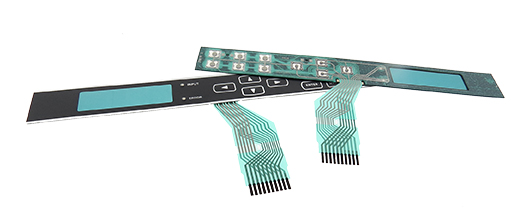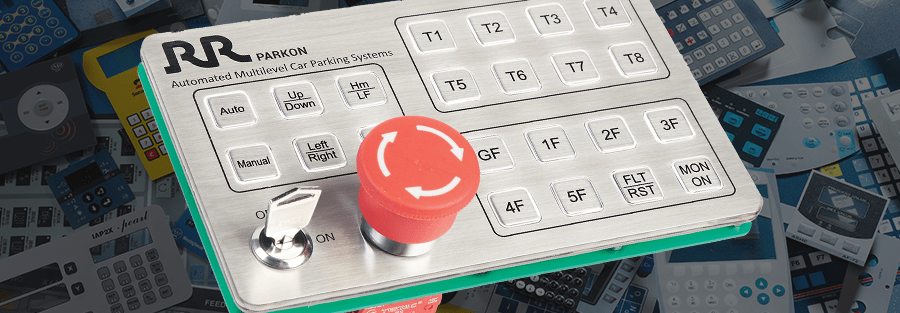Why Membrane Switches Are a Secret Element in Modern Electronic Gadgets
Why Membrane Switches Are a Secret Element in Modern Electronic Gadgets
Blog Article
Membrane Switches Explained: A Comprehensive Guide to Their Advantages
Membrane layer switches represent a versatile and advanced service for developing customer interfaces across a variety of fields. As industries progressively look for effective and dependable control interfaces, recognizing the particular benefits and applications of membrane changes becomes important.
What Are Membrane Switches?

When pressure is applied to the membrane layer button, the layers make call, finishing an electrical circuit. This easy device enables a broad range of applications, from customer electronics to industrial machinery. Membrane layer switches are commonly developed to be water resistant and immune to dust and pollutants, making them suitable for atmospheres where sturdiness is essential.
Additionally, the flexibility of the materials made use of in membrane changes assists in cutting-edge layouts that can adapt numerous shapes and dimensions. This flexibility adds to their popularity in varied fields, including medical gadgets, auto controls, and home appliances. In general, membrane layer switches over stand for a vital aspect in modern user interface technology, bridging the gap in between individuals and electronic systems.
Key Advantages of Membrane Buttons
Amongst the myriad of interface alternatives readily available, membrane layer changes stand apart for their unique combination of benefits. Among the primary benefits is their light-weight and compact layout, which enables combination into a variety of devices without adding significant bulk. This is specifically helpful in applications where area is restricted.
Furthermore, membrane layer changes deal durability and resistance to ecological factors. They are typically constructed with materials that can withstand dampness, dirt, and various chemicals, making them suitable for rough problems. This toughness adds to a much longer lifespan compared to conventional mechanical switches.
Another significant benefit is the flexibility in customization. Membrane switches can be published with various graphics, shades, and textures, enabling tailored styles that satisfy specific branding or useful needs. This versatility extends to the number of layers and circuit choices, giving designers with numerous configurations.
Additionally, the responsive responses provided by some membrane changes enhances customer experience, making them much more intuitive to operate. Lastly, the ease of cleansing and upkeep further solidifies membrane layer buttons as a practical selection in both consumer and industrial applications. Membrane Switches. On the whole, these crucial advantages make them a preferred option for many designers and suppliers
Applications in Different Industries
How do membrane switches find their place across varied markets? Their convenience and capability make them integral components in markets varying from healthcare to consumer electronics. In clinical tools, membrane layer buttons are utilized for their ease of cleansing and resistance to contamination, guaranteeing hygiene in environments where sterility is essential.
In the consumer electronic devices industry, these buttons offer streamlined, user-friendly interfaces that enhance product visual appeals while preserving durability versus wear and tear. Automotive applications gain from membrane switches as well, where they are used in dashboards and control board, providing dependable performance in tough problems.
Additionally, commercial machinery employs membrane switches for control panels due to their toughness, capacity to endure severe atmospheres, and customizable layouts that cater to certain operational requirements. The food market leverages membrane switches for their convenience of use and resistance to spills, guaranteeing functional effectiveness in fast-paced settings.
Inevitably, the flexibility of membrane layer changes across these varied applications underscores their essential function in modern-day technology, enhancing individual communication while satisfying industry-specific requirements. Their continued development guarantees further combination right into emerging areas and ingenious items.
Style and Modification Alternatives
The design and customization alternatives readily available for membrane layer switches are important for customizing user interfaces to satisfy details user demands and visual preferences. These buttons can be created in numerous shapes, sizes, and layouts, permitting seamless combination into diverse applications. The adaptability in style implies that makers can create special user interfaces that boost use and maintain brand identity.
Customized shades, textures, and graphics can be put on the surface area of the membrane button, giving a chance for branding and customer interaction. Furthermore, backlighting alternatives, such as LED illumination, can be incorporated to boost exposure in low-light conditions, thus improving capability.
Functional components can also be customized, consisting of tactile comments and actuation force, which can be adapted to suit various individual communications. The option of materials, such as polyester or polycarbonate, enables variants in durability and ecological resistance, satisfying the specific needs of various sectors.
Eventually, the substantial layout and modification abilities of membrane layer switches make it possible for business to develop easy to use and visually attractive user interfaces, making sure that their products satisfy both visual and practical needs efficiently. Membrane Switches.
Considerations for Execution
Executing membrane layer changes needs cautious factor to consider of numerous variables to guarantee optimal performance and individual experience. Factors such as exposure to wetness, extreme temperatures, and chemical article compounds can dramatically affect the button's efficiency and long life.

Another important element is the button's design and layout. Ensuring that the tactile feedback and actuation force from this source align with user assumptions improves functionality. Conducting customer testing can supply beneficial understandings into the ideal style.
Furthermore, compatibility with electronic components have to be examined. The button's wiring must align with the overall system architecture, making sure reliable signal transmission and minimizing interference.
Furthermore, production techniques and prices need to be examined. The selection in between personalized designs and conventional versions can affect both spending plan and lead time.
Last but not least, take into consideration repair and maintenance. Membrane layer buttons may require particular cleaning and care treatments to preserve their look and capability in time. By attending to these factors to consider, companies can apply membrane layer switches that satisfy their functional requirements while giving a positive individual experience.

Verdict
In conclusion, membrane layer switches stand for a functional and durable control user interface appropriate for a broad array of applications across numerous markets. Membrane Switches. As innovation continues to progress, the relevance of membrane buttons in contemporary gadgets continues to be significant, supplying both capability and aesthetic appeal.
Membrane changes stand for a flexible and innovative service for creating customer interfaces across a range of markets.Recognizing the fundamental parts of modern-day digital user interfaces, membrane layer switches are a kind of customer interface device Learn More Here that are composed of flexible, thin layers of product. On the whole, membrane changes represent a vital aspect in modern-day individual interface innovation, connecting the gap in between customers and digital systems.
Among the myriad of individual interface alternatives offered, membrane layer changes stand out for their unique mix of advantages.The style and customization options offered for membrane layer buttons are important for customizing user interfaces to meet certain user needs and aesthetic preferences.
Report this page